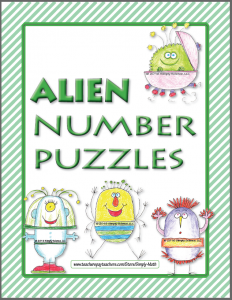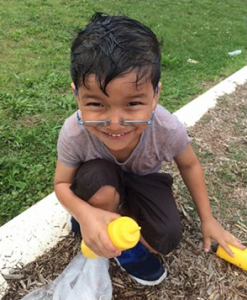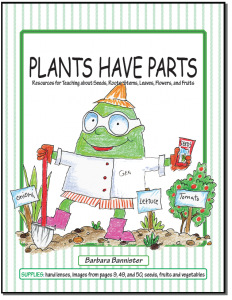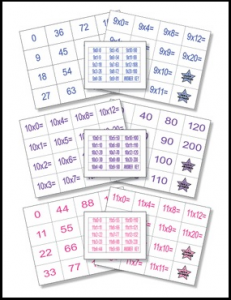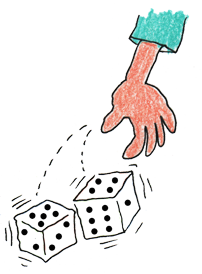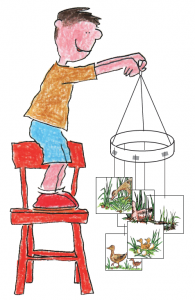Quick puzzles can add a bit of fun to your math class any time of year. I created a set of alien puzzles that you can use to have students find a number pattern and then solve the puzzles to reveal a math term! There are 6 different kinds of puzzles – each has its own alien. Choose from full color or black and white images. Students can use a blank form to create a new puzzle for classmates and receive a certificate. You can also find many kinds of puzzles online, including: Brainbox Logic Puzzles, Kid Number Puzzles, and number …
Check out this great article Justin Minkel wrote for Education Week with practical suggestions for ending your school year. Consider signing up for a free subscription to three articles a month so you can read the article he referenced about building a parachute for a thrill-seeking gummy bear. I hope you enjoy the end of your year! Note: The photo was taken by Justin Minkel.
Got a few minutes of class time? Want to amaze students with an activity that requires scrap paper and just two paper clips? Gently fold a piece of paper the size of a dollar bill (about 2.5″ x 6″) paper in thirds without creasing the paper. Use a paper clip to attach the top to the middle as shown. Use another paper clip to attach the bottom to the middle as shown. Turn the prepared paper so the paper clips are on top. Firmly grasp the paper on each side and point it away from you toward an open space in the classroom. …
Thanks to what I learned while taking a great class from Michael Grinder mid-career, I have dedicated different parts of my classroom to a unique purpose. I find this gives students a nonverbal clue that helps them make sense of our environment. When anyone is standing or sitting in the front of the room, we are sharing information or instructions for an activity. We’re focused on the presenter. We might be discussing, clarifying, or sharing with each other. When I’m sitting at the small table by my desk, I’m working with a small group of students. The rest of the group is working on an activity I’ve already …
Here’s a concise list of key strategies for you to consider as you deepen your effectiveness in the classroom. Thanks to Samantha Cleaver at Scholastic.com Do you have other suggestions for being an effective teacher?
I just added a new product to my store at TPT, Plants have Parts!  It features a wealth of resources including the lesson plan, PowerPoint presentations, movies, copyright free images, worksheets, a student booklet, assessments, and a web page with more resources. Check it out! I’ve also uploaded freebies – seek-a-word puzzles for plant parts and seek-a-word puzzles for fruits that students often confuse with vegetables. Are you interested in integrating plants and language arts? Consider Jack Prelutsky’s poems “The Cherries’ Garden Gala” or “I’d Never Eat a Beet” from his book New Kid on the Block. You might create an ABC book for plants. Here’s a list …
Do your students need to practice a basic math skill? Do you want them to be more confident using that skill Would you like to send a game home so students can practice math with family members? While playing a Memory Game, students match up numbers with names, computation problems with their answers, fractions with their equivalents and much, much more! Print a set of cards and an answer key, zip both in a bag, and you have an easy to store game that’s an excellent way to spend a few minutes in class, review an important skill, or reward carefully completed work. When you create games …
How is it possible I can buy dice and somehow they evaporate over time? I know it’s rare for a solid to sublimate into a gas, but every June I end up with far fewer dice than I had in September. And the ones I have can be in pretty bad shape. I hesitate to send dice home with math games because I know they don’t always come back to school. Many of my math games require dice so here’s my suggestion for you: use a six sided pencil! A student sharpens a pencil until it’s too short to sharpen. Do you …
Are your students learning about the life cycle of a frog, bird, bug, whale, or cat? Are you collecting resources to meet NGSS 3-LS1-1? (Develop models to describe that organisms have unique and diverse life cycles but all have in common birth, growth, reproduction, and death.) With this FREE product, students cut apart squares that represent the stages in an animal’s life, glue them back-to-back with a piece of string between the images, and then suspend the images in a spiral from an embroidery hoop or a loop make from a folded piece of construction paper. Choose from blackline images, color images, or blank …
Teaching a unit about force? Poetry can be a great addition to your science resources. Read about ten ways to use poetry in your classroom from Reading Rockets. In addition to my list of poetry by Shel Silverstein, here are suggestions for poems you might consider sharing with your students. The Butterfly Jar, Jeff Moss force: “London Bridge” A Pizza the Size of the Sun, Jack Prelutsky buoyancy: “We Often Walk on Water” magnetism: “I’m Practically Covered with Needles and Pins” Something Big has Been Here, Jack Prelutsky force: “The Turkey Shot Out of the Oven” These could support activities …
